- Focus: Big Food goes small: Kraft Heinz bets on simplicity to boost shares Reuters
- Warren Buffett says he is ‘disappointed’ in Kraft Heinz split; shares fall 7% CNBC
- Kraft Heinz is splitting up, separating hot dogs from ketchup NPR
- Submit nominations for 2026 Iowa STEM teacher award Daily Gate City
- Google avoids breakup in search monopoly case, but judge orders other major changes in landmark ruling Barchart.com
Author: admin
-
Focus: Big Food goes small: Kraft Heinz bets on simplicity to boost shares – Reuters
-
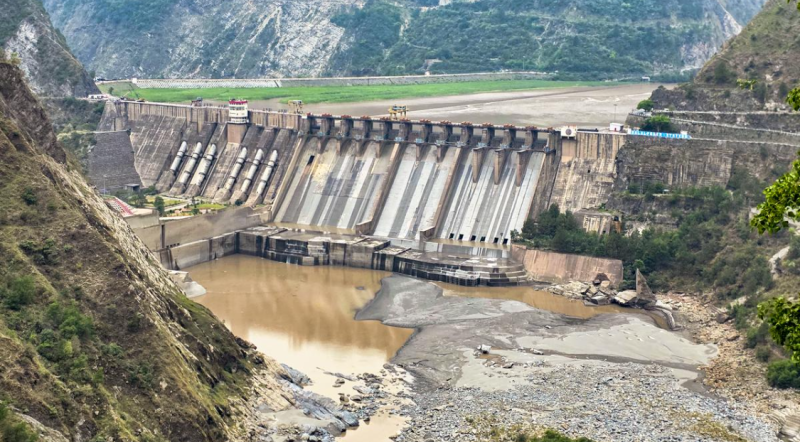
Pakistan’s perspective on India’s abeyance of Indus Waters Treaty
The Indus Waters Treaty (IWT), brokered by the World Bank in 1960, has been a cornerstone of transboundary water cooperation between India and Pakistan for over six decades. However, India’s recent decision to unilaterally suspend the treaty following the Pahalgam attack (June 2025) marks a dangerous escalation in the use of water as a geopolitical weapon.
From Pakistan’s perspective, this move is not only legally untenable but also a grave threat to its food security, economy, and regional stability. This document outlines Pakistan’s legal recourse, strategic countermeasures, and the broader implications of India’s actions under international law.
Can India Legally Stop Water Flows to Pakistan? An International Legal Perspective
1. India’s Legal Capacity to Halt Water Flows Under the Indus Waters Treaty (IWT)
The Indus Waters Treaty (1960) explicitly governs water distribution between India and Pakistan, allocating:
- Eastern Rivers (Ravi, Beas, Sutlej): Full control to India (with limited non-consumptive use for Pakistan).
- Western Rivers (Indus, Jhelum, Chenab): Guaranteed flow to Pakistan, with India permitted limited storage and hydroelectric use.
2. Can India Legally Stop Western Rivers’ Water?
- No unilateral stoppage allowed: The IWT does not grant India the right to completely block water to Pakistan.
- Permitted uses only: India can build run-of-the-river hydro projects (no large storage) and use water for non-consumptive purposes (e.g., electricity generation).
- Violation if India diverts or blocks: Any attempt to cut off or excessively store Western Rivers’ water breaches Article III (Pakistan’s unrestricted use) and Annexure D (storage limits).
3. International Law on Water Suspension: Key Principles
Even if India claims “abeyance” (temporary suspension), international law imposes strict limits:
A. Vienna Convention on the Law of Treaties (VCLT)
Article 60 (Termination/Suspension): Only valid if Pakistan commits a “material breach” (e.g., repudiating the treaty or violating essential terms).
Pakistan has not done so—using arbitration (Kishenganga/Ratle cases) is permitted under IWT dispute mechanisms.
Article 62 (Fundamental Change of Circumstances): Does not apply—political tensions (e.g., terrorism) do not alter the treaty’s water-sharing purpose (ICJ ruling in Gabčíkovo-Nagymaros Case).B. UN Watercourses Convention (1997)
Equitable & Reasonable Utilization (Article 5): India cannot disproportionately harm Pakistan’s water rights.
No Significant Harm Rule (Article 7): Cutting off water violates Pakistan’s right to livelihood, agriculture, and drinking water.C. International Humanitarian Law (IHL)
If India weaponizes water, it could amount to:
Collective punishment (prohibited under Geneva Conventions).
Crime against humanity (via mass starvation, per Rome Statute).Is “Abeyance” a Valid Legal Concept in International Law?
1. Definition of Abeyance
- Temporary suspension of treaty obligations (not termination).
- No explicit recognition in the Vienna Convention but sometimes used in state practice.
2. Legal Validity of India’s “Abeyance” Claim
- No Basis in the IWT: The treaty does not allow temporary suspension for political reasons.
ICJ Precedent Against It:
- In Gabčíkovo-Nagymaros, Hungary tried suspending a water treaty—ICJ ruled unilateral suspension illegal.
- Only mutual agreement or UNSC sanctions can justify suspension.
Risk of Illegal Countermeasure:
- Under customary international law, countermeasures must be:
- Proportionate (India’s total suspension is excessive).
- Reversible (long-term harm to Pakistan makes this doubtful).
3. Consequences of Invalid Abeyance
- Pakistan can challenge in ICJ/World Bank for treaty violation.
- World Bank (IWT guarantor) may freeze funding for Indian projects.
- UNSC could intervene if framed as a threat to peace (though veto risks exist).
Conclusion: India Cannot Legally Stop Water to Pakistan
- IWT binds India to let Western Rivers flow—no legal right to block.
- “Abeyance” has no standing—only mutual agreement or UNSC order can suspend treaties.
- Pakistan’s recourse:
- World Bank arbitration (compel India to restore flows).
- ICJ case (for breach of UN Watercourses Convention).
- Diplomatic pressure (OIC, UN, China-backed resolutions).
India’s move is a dangerous precedent in “water wars”—but international law firmly sides with Pakistan’s rights.
Legal Analysis: India’s Suspension and Violations of International Law
1. Invalidity of India’s Claims Under the Vienna Convention
India justifies its suspension of the IWT by invoking Article 60 of the Vienna Convention on the Law of Treaties (VCLT), alleging a “material breach” by Pakistan. However, We can categorically rejects this argument for the following reasons:
- No Material Breach by Pakistan:
- The IWT is a technical water-sharing agreement, not a counter-terrorism pact. India’s attempt to link Pakistan’s alleged support for militants to the treaty is legally irrelevant.
- Pakistan has not repudiated the treaty nor violated its “essential provisions.” Dispute resolution mechanisms (e.g., Kishenganga arbitration) are permissible under the IWT and do not constitute a breach.
- Precedent from the Gabčíkovo-Nagymaros Case (1997):
- The International Court of Justice (ICJ) ruled that political tensions or unilateral grievances (e.g., terrorism allegations) do not justify treaty termination.
- The ICJ’s strict interpretation of Article 62 (fundamental change of circumstances) further undermines India’s position.
2. Violation of Customary International Law
India’s suspension of water flows could constitute:
- Collective Punishment: Depriving millions of civilians of water violates international humanitarian law and the UN Watercourses Convention (1997), which mandates equitable and reasonable utilization.
- Disproportionate Countermeasure: Under the UN Charter (Article 51), any response must be proportional. India’s actions far exceed this threshold.
Pakistan’s Legal Recourse
Pakistan can challenge India’s actions through multiple forums:
1. World Bank Arbitration (Article IX of IWT)
- The IWT mandates neutral expert intervention for disputes. Pakistan can demand urgent arbitration to enforce India’s compliance.
- Precedent: The 2013 Kishenganga ruling forced India to modify its dam design.
2. International Court of Justice (ICJ)
- Pakistan can file a case citing:
- Breach of the UN Watercourses Convention (equitable utilization).
- Violation of the IWT’s core provisions (e.g., unrestricted flow of Western Rivers).
3. United Nations Security Council (UNSC)
- Pakistan, with support from allies like China, can table a resolution condemning India’s actions as a threat to regional peace.
- Risk: Potential veto by Russia or other powers.
Strategic Countermeasures for Pakistan
1. Hydrological Resilience
- Accelerate Dam Projects: Fast-track completion of Diamer-Bhasha Dam (2026) to enhance water storage.
- Cloud Seeding: Invest in technology to augment rainfall and glacier replenishment.
2. Diplomatic Offensive
- Organisation of Islamic Cooperation (OIC) Summit: Mobilize Muslim-majority nations to pressure India.
- Leverage CPEC: Secure Chinese support for infrastructure and legal advocacy.
3. Economic and Humanitarian Safeguards
- Diversify Agriculture: Shift to drought-resistant crops to mitigate losses.
- International Aid Appeals: Highlight the humanitarian crisis to secure UN and donor assistance.
Global Implications and Precedents
India’s actions set a perilous precedent for transboundary water conflicts:
- Türkiye could mimic similar tactics against Syria and Iraq over the Euphrates.
- Ethiopia might harden its stance on the Nile Dam dispute, escalating tensions with Egypt and Sudan.
- Climate Change Multiplier: Melting glaciers and water scarcity will exacerbate such conflicts, risking “21st-century water wars.”
Conclusion and Recommendations
India’s suspension of the IWT is a blatant violation of international law and an existential threat to Pakistan. While legal avenues offer some recourse, the urgency demands immediate action:
- Exhaust All Legal Channels: File cases at the ICJ and World Bank to force India’s compliance.
- Strengthen Water Infrastructure: Reduce dependency on Indian-controlled rivers through dams and alternative sources.
- Global Coalition-Building: Rally international support to condemn hydrological warfare and uphold the IWT.
Indus crisis is not just a bilateral issue—it is a test of the world’s commitment to preventing resource-driven conflicts. Pakistan must act decisively to safeguard its survival and set a precedent against the weaponization of water.
Continue Reading
-

Valneva Reports Further Positive Phase 2 Safety and
- Strong immune response after third yearly booster dose in children and adults
- Significant anamnestic antibody response across all six serotypes
- No safety concerns observed in any age group by independent Data Monitoring Committee (DMC), consistent with previous booster results.
Saint-Herblain (France), September 3rd, 2025 – Valneva SE (Nasdaq: VALN; Euronext Paris: VLA) announced positive immunogenicity and safety data from the ongoing Phase 2 study of Lyme disease vaccine candidate, VLA15. The strong anamnestic immune response and favorable safety profile following a third booster dose were consistent with those reported after receiving previous annual booster doses1,2 further demonstrating compatibility with the anticipated benefits of a yearly vaccination prior to each Lyme season.
There are currently no approved human vaccines for Lyme disease, and VLA15 has advanced the furthest in clinical development, with two Phase 3 trials nearing completion. The Centers for Disease Control and Prevention (CDC) estimates that approximately 476,000 people in the U.S. are diagnosed and treated for Lyme disease each year, and 132,000 cases are reported annually in Europe.3,4 Vaccination has been completed in the pivotal Phase 3 study of VLA155, and subject to positive data, Pfizer aims to submit a Biologics License Application (BLA) to the U.S. Food and Drug Administration (FDA) and Marketing Authorization Application (MAA) to the European Medicines Agency (EMA) in 2026.
Juan Carlos Jaramillo M.D., Chief Medical Officer of Valneva, said, “These latest data further reinforce the potential benefits of booster doses across all evaluated age groups. There are currently no approved human vaccines for Lyme disease, and as the disease continues to expand geographically, it remains a pressing unmet medical need affecting communities across the Northern Hemisphere. Each set of positive results moves us closer to the possibility of making this vaccine available to both adults and children living in Lyme-endemic areas.”
These latest results from the VLA15-221 Phase 2 study – measured one month after vaccination at month 42 – again demonstrated a significant anamnestic antibody response across all six serotypes covered by the vaccine candidate in pediatric (5 to 11 years of age) and adolescent (12 to 17 years of age) participants, as well as in adults (18 to 65 years of age). A high proportion of participants seroconverted after the third booster dose, yielding seroconversion rates* (SCRs) at 100% (confidence interval 96.7%, 100%) for all outer surface protein A (OspA) serotypes in all age groups, in-line with SCRs after the first and second booster. Geometric Mean Titers at one month post first and second booster (i.e. month 19 vs. month 31) were comparably high.
The safety and tolerability profile of VLA15 after the third booster dose was similar to the profile observed after the previous booster doses. To date, no safety concerns have been observed by the independent DMC in any treatment or age group.
Pfizer and Valneva entered into a collaboration agreement in April 2020 for the development and commercialization by Pfizer of VLA15.
Participants in this Phase 2 study received VLA15 or placebo during the primary vaccination phase in two immunization schedules (month 0-2-6 or month 0-6), followed by yearly vaccinations at months 18, 30 and 42. In August 2022, Pfizer and Valneva initiated the currently ongoing Phase 3 clinical study, Vaccine Against Lyme for Outdoor Recreationists (VALOR) (NCT05477524), to investigate the efficacy, safety and immunogenicity of VLA15 in participants five years of age and older in highly endemic regions in North America and Europe.6 Dosing of all subjects was recently completed as announced by Pfizer. A second Phase 3 trial (C4601012), aiming to provide further evidence on the safety profile of VLA15 in the pediatric population between 5 and 17 years of age also completed vaccination.
About VLA15
There are currently no approved human vaccines for Lyme disease, and VLA15 is the Lyme disease vaccine candidate which has advanced the furthest along the clinical development timeline, with two Phase 3 trials in progress. This investigational multivalent protein subunit vaccine uses an established mechanism of action for a Lyme disease vaccine that targets the outer surface protein A (OspA) of Borrelia burgdorferi, the bacteria that cause Lyme disease. OspA is a surface protein expressed by the bacteria when present in a tick. Blocking OspA inhibits the bacterium’s ability to leave the tick and infect humans. The vaccine candidate covers the six most prevalent OspA serotypes expressed by the Borrelia burgdorferi sensu lato species in North America and Europe.
About Clinical Study VLA15-221
VLA15-221 is a randomized, observer-blind, placebo-controlled Phase 2 study. It is the first clinical study with VLA15 which enrolled a pediatric population (5-17 years old). 560 healthy participants received either VLA15 in two immunization schedules (month 0-2-6 [N=190] or month 0-6 [N=181]) or placebo (month 0-2-6 [N=189]). Vaccine recipients received VLA15 at a dose of 180 µg, which was selected based on data generated in two previous Phase 2 studies. The main safety and immunogenicity readout (primary endpoint) was performed one month after completion of the primary series vaccination schedule. All eligible subjects received yearly booster doses of VLA15 or placebo at Months 18, 30 and 42. Antibody persistence will be followed up to six months post third annual booster.
VLA15 is tested as an alum-adjuvanted formulation and administered intramuscularly. The study is being conducted at U.S. sites located in areas where Lyme disease is endemic and has enrolled both volunteers with a prior infection with Borrelia burgdorferi as well as Borrelia burgdorferi-naïve volunteers.About Lyme Disease
Lyme disease is a systemic infection caused by Borrelia burgdorferi bacteria transmitted to humans by the bite of infected Ixodes ticks.7 It is considered the most common vector-borne illness in the Northern Hemisphere.8,9 While the true incidence of Lyme disease is unknown, the Centers for Disease Control and Prevention (CDC) has estimated that approximately 476,000 people in the U.S. are diagnosed and treated each year and 132,000 cases are reported annually in Europe. Early symptoms of Lyme disease (such as a gradually expanding erythematous rash called erythema migrans or other nonspecific symptoms like fatigue, fever, headache, mild stiff neck, muscle and joint paints) are often overlooked or misinterpreted. Left untreated, the disease can disseminate and cause more serious chronic complications affecting the skin, joints (arthritis), the heart (carditis) or the nervous system. The medical need for vaccination against Lyme disease is steadily increasing as the geographic footprint of the disease widens.10
About Valneva SE
We are a specialty vaccine company that develops, manufactures, and commercializes prophylactic vaccines for infectious diseases addressing unmet medical needs. We take a highly specialized and targeted approach, applying our deep expertise across multiple vaccine modalities, focused on providing either first-, best- or only-in-class vaccine solutions.
We have a strong track record, having advanced multiple vaccines from early R&D to approvals, and currently market three proprietary travel vaccines.
Revenues from our growing commercial business help fuel the continued advancement of our vaccine pipeline. This includes the only Lyme disease vaccine candidate in advanced clinical development, which is partnered with Pfizer, the world’s most clinically advanced tetravalent Shigella vaccine candidate as well as vaccine candidates against the Zika virus and other global public health threats.
Valneva Forward-Looking Statements
This press release contains certain forward-looking statements relating to the business of Valneva, including with respect to the progress, timing, results and completion of research, development and clinical trials for product candidates and the timing for submission of such product candidates for regulatory approval. In addition, even if the actual results or developments of Valneva are consistent with the forward-looking statements contained in this press release, those results or developments of Valneva may not be sustained in the future. In some cases, you can identify forward-looking statements by words such as “could,” “should,” “may,” “expects,” “anticipates,” “believes,” “intends,” “estimates,” “aims,” “targets,” or similar words. These forward-looking statements are based largely on the current expectations of Valneva as of the date of this press release and are subject to a number of known and unknown risks and uncertainties and other factors that may cause actual results, performance or achievements to be materially different from any future results, performance or achievement expressed or implied by these forward-looking statements. In particular, the expectations of Valneva could be affected by, among other things, uncertainties involved in the development and manufacture of vaccines, unexpected clinical trial results, unexpected regulatory actions or delays, competition in general, currency fluctuations, the impact of the global and European credit crisis, and the ability to obtain or maintain patent or other proprietary intellectual property protection. Success in preclinical studies or earlier clinical trials may not be indicative of results in future clinical trials. In light of these risks and uncertainties, there can be no assurance that the forward-looking statements made in this press release will in fact be realized. Valneva is providing this information as of the date of this press release and disclaims any intention or obligation to publicly update or revise any forward-looking statements, whether as a result of new information, future events, or otherwise.
Valneva Media and Investor Relations Contacts
Laëtitia Bachelot-Fontaine
VP Global Communications & European Investor Relations
M +33 (0)6 4516 7099
laetitia.bachelot-fontaine@valneva.comJoshua Drumm, Ph.D.
VP Global Investor Relations
M +1 917 815 4520
joshua.drumm@valneva.comReferences
1 https://valneva.com/press-release/valneva-and-pfizer-report-positive-pediatric-and-adolescent-phase-2-booster-results-for-lyme-disease-vaccine-candidate/
2 https://valneva.com/press-release/valneva-and-pfizer-report-further-positive-phase-2-booster-results-for-lyme-disease-vaccine-candidate/
3 Davidson, A., Davis, J., Brestrich, G., Moisi, J., Jodar, L., & Stark, J. H. July 2025. Vector Borne Zoonotic Diseases. (online ahead of print).
4 Centers for Disease Control and Prevention. Lyme Disease. January 2021. Available at:
https://www.cdc.gov/lyme/stats/humancases.html. Accessed: August 2023.
5 Second-Quarter 2025 Earnings Conference Call Prepared Remarks August 5, 2025: https://s206.q4cdn.com/795948973/files/doc_financials/2025/q2/Q2-2025-Earnings-Conference-Call-Prepared-Remarks-FINAL.pdf
6 Pfizer and Valneva Initiate Phase 3 Study of Lyme Disease Vaccine Candidate VLA15. August 2022. Available at: https://valneva.com/press-release/pfizer-and-valneva-initiate-phase-3-study-of-lyme-disease-vaccine-candidate-vla15/ Accessed: August 2023.
7 Stanek et al. 2012, The Lancet 379:461–473
8 Centers for Disease Control and Prevention. Lyme Disease. January 2021. Available at:
https://www.cdc.gov/lyme/stats/humancases.html Accessed: August 2024.
9 Kugeler KJ, et al. Estimating the frequency of Lyme disease diagnoses—United States, 2010-2018. 2021. Emergency Infectious Disease. 27(2).
10 Centers for Disease Control. Understanding Lyme and Other Tickborne Diseases. May 2022. Available from: https://www.cdc.gov/ticks/communication-resources/press-kit.html?CDC_AAref_Val=https://www.cdc.gov/ncezid/dvbd/media/lyme-tickborne-diseases-increasing.html Accessed: August 2025.- 2025_09_03_VLA15-221_m42_PR_EN_Final
Continue Reading
-

The Great Square of Pegasus
This famous four-star asterism marks the body of Pegasus the Winged horse and can help point the way to many fainter objects.
- The article describes the observation of the Great Square of Pegasus, an asterism easily visible throughout the night due to its brightness.
- The asterism comprises four stars: Gamma Pegasi, Markab (Alpha Peg), Scheat (Beta Peg), and Alpheratz (Andromeda’s Alpha star), with approximate magnitudes and relative positions described.
- The observation is best performed an hour after sunset, with the square rising in the east and traversing the sky overnight.
- Despite the waxing gibbous moon, the article suggests learning the Great Square as a reference point for finding fainter celestial objects under darker skies.
With a waxing Moon lighting the sky for most of the night, we’re focusing on brighter stars this evening. Our target for tonight is a famous asterism that is currently visible all night long. You can catch it already above the horizon in the east an hour after the Sun disappears, then follow its progress as it arcs through the sky overnight.
Look east an hour after sunset and you’ll spot a large diamond of stars — this is the Great Square of Pegasus, which depicts the body of the Winged Horse. It is bounded by four stars; lowest early in the evening is magnitude 2.8 Gamma Pegasi. Moving counterclockwise, some 16.5° to its upper right (west) is magnitude 2.5 Markab (Alpha Peg). The next star is Scheat (Beta Peg), which shines at magnitude 2.5 and sits roughly 13° north (to the upper left) of Markab. As the Great Square is Rising, Scheat appears at the top of the diamond, directly above Gamma.
Finishing off the Great Square is a star that isn’t actually in Pegasus — it’s Alpheratz, Andromeda’s magnitude 2.1 alpha star, which lies just over 14° east (to the lower left) of Scheat.
Although the sky is bright with moonlight tonight, taking the time to learn the Great Square will help guide your way to many fainter objects when the nights grow darker again.
Sunrise: 6:30 A.M.
Sunset: 7:28 P.M.
Moonrise: 5:27 P.M.
Moonset: 1:34 A.M.
Moon Phase: Waxing gibbous (82%)
*Times for sunrise, sunset, moonrise, and moonset are given in local time from 40° N 90° W. The Moon’s illumination is given at 12 P.M. local time from the same location.For a look ahead at more upcoming sky events, check out our full Sky This Week column.
Continue Reading
-
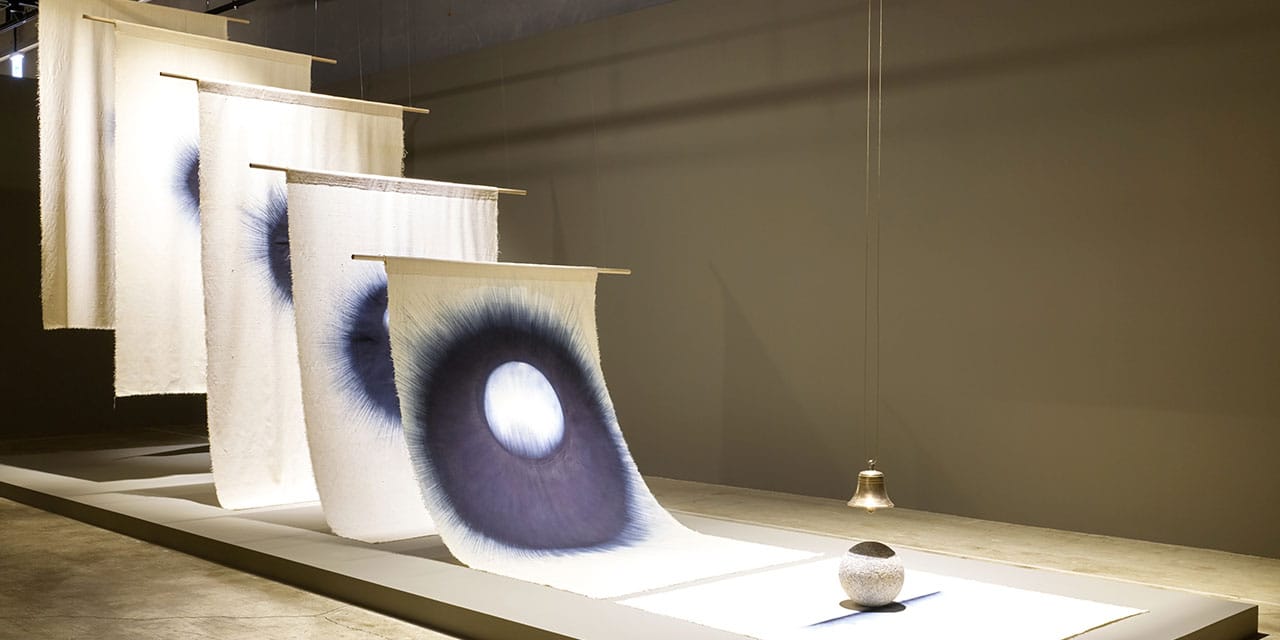
Hyundai Motor Announces the Opening of Hyundai Translocal Series: Entangled and Woven
After its premiere in Cheongju Craft Biennale 2025, Hyundai Translocal Series: Entangled and Woven will travel to the National Crafts Museum & Hastkala Academy in New Delhi, India in February 2026 and to the Whitworth in Manchester, UK in July 2026.
Hyundai Translocal Series: Entangled and Woven
September 4, 2025 – November 2, 2025, Cheongju Craft Biennale 2025
In partnership with Hyundai Motor Company
*These images are approved only for publication in conjunction with the promotion of Hyundai Translocal Series: Entangled and Woven. Each image must not be cropped, bled off the page, colorized, solarized, overlaid with other elements (e.g., tone, text, another image, etc.), or otherwise altered, except in terms of overall size. Reproductions must include the full credit information adjacent to the image. Use of images for front covers may incur a fee and will require prior authorization from the owner and copyright holder of the work. Please contact the Press Office of Cheongju Craft Biennale 2025 for such use at [email protected] or [email protected].
Image Credit
– Image 1: Kaimurai, The Answer to All My Prayers Are in the Questions I Never Asked, 2025, installation view in Hyundai Translocal Series: Entangled and Woven, Cheongju Craft Biennale 2025 © Cheongju Craft Biennale Organizing Committee, photo by Wooil Kim
– Image 2: Jounghye Yoo, Gilded Veil_A Mysterious Curtain Lightly Draped in Gold, 2025, installation view in Hyundai Translocal Series: Entangled and Woven, Cheongju Craft Biennale 2025 © Cheongju Craft Biennale Organizing Committee, photo by Wooil Kim
– Image 3: Boito, Mohenjodaro Textile, 2025, installation view in Hyundai Translocal Series: Entangled and Woven, Cheongju Craft Biennale 2025 © Cheongju Craft Biennale Organizing Committee, photo by Wooil Kim
– Image 4: Sumakshi Singh, Spanning the void, 2025 and PÉRO, Entangled Memories, Interwoven Stories, 2025, installation view in Hyundai Translocal Series: Entangled and Woven, Cheongju Craft Biennale 2025 © Cheongju Craft Biennale Organizing Committee, photo by Wooil Kim
– Image 5: Somi Ko, People of One, Continuum, 2025, installation view in Hyundai Translocal Series: Entangled and Woven, Cheongju Craft Biennale 2025 © Cheongju Craft Biennale Organizing Committee, photo by Wooil Kim
– Image 6: Yeonsoon Chang, Worincheongang I, 2025, installation view in Hyundai Translocal Series: Entangled and Woven, Cheongju Craft Biennale 2025 © Cheongju Craft Biennale Organizing Committee, photo by Wooil Kim
– Image 7: Youngin Hong, Sacred Empires, 2025, installation view in Hyundai Translocal Series: Entangled and Woven, Cheongju Craft Biennale 2025 © Cheongju Craft Biennale Organizing Committee, photo by Wooil Kim
Continue Reading
-

Does Protein Timing Matter for Muscle Growth?
- Total daily protein matters the most for muscle building, rather than protein timing.
- Muscle building is the result of strength training and eating enough daily protein.
- To eat more protein, eat high-protein snacks and consider using a protein powder if needed.
Protein is the MVP when it comes to building muscle. Strength training tears down muscles—in a good way—and protein steps in to rebuild them bigger and stronger over time. With the conversation around protein being louder than ever, you may be wondering if you’re timing your protein intake right to maximize those gains.
To help answer this question, we asked sports dietitians whether there’s really a “best” time to eat protein for muscle growth. Spoiler: The answer isn’t so simple. Keep reading to learn why strict protein timing may not be the best strategy for supporting muscle growth.
Is There a Best Time?
The honest answer: not necessarily. “The good news is that if your overall protein intake is solid throughout the day, the exact timing matters less than you think,” says Nazirber Maduro, RD, CDN, CDCES, a registered dietitian. What matters most is the amount of total protein you eat in a day, not when you eat it. “While some early research suggested dividing protein equally throughout the day was necessary for maximizing protein usage, current data has suggested the total protein intake over the course of the day is most important,” explains Christopher R. Mohr, Ph.D., RD, an exercise physiologist and dietitian.
For example, one study in 31 men found no difference in muscle growth based on protein timing. Over eight weeks, participants were split into two groups: one group consumed protein immediately before and after their workouts, while the other group consumed the same amount three hours before and after. Results indicated both groups experienced similar muscle gains, regardless of protein timing.
Another large review study found that certain times of the day—such as post-exercise and before bed to support recovery during sleep—may offer added benefits for muscle building. However, the authors noted that higher-quality studies are needed. Overall, they concluded that total protein intake remains the most important factor, meaning that as long as you eat enough protein throughout the day, you’ll likely see results.
Finally, Mohr highlights a recent study that looked at meal timing and protein intake. Participants were instructed to eat their total protein needs across just two meals, instead of the typical three. The goal was to see whether sufficient muscle growth could occur as long as daily protein needs were met, even with fewer eating occasions. The results showed that as long as participants ate enough total protein (1.5 grams per kilogram of body weight per day or 0.7 g/lb./day), this supported muscle growth.
As the research suggests, the debate on protein timing can be put to rest. This is good news for individuals practicing intermittent fasting or those who find it hard to eat protein at certain times of the day.
Other Factors to Consider
Total Protein Intake
“Ninety percent of building muscle is due to strength training, not protein. However, if one does not consume enough protein, the body will be in a state of protein breakdown instead of protein synthesis,” says Leslie Bonci, M.P.H., RDN, CSSD, LDN, FAND, a sports dietitian. This underscores how important it is to meet your daily protein needs if you want to see results.
While protein needs vary depending on activity level, age and goals, most research aligns with the International Society of Sports Nutrition’s recommendation that active individuals should consume around 1.4 to 2.0 g/kg/day (0.64–0.90 g/lb./day). This means someone weighing 150 pounds (68 kg) would need roughly 95 to 136 grams of protein per day.
While protein timing isn’t the most important factor for muscle growth, Mohr notes that some people may still find it easier to spread protein evenly throughout the day, since it’s quite filling. Others may prefer fewer, larger meals. As the saying goes, “different strokes for different folks.”
Protein Quality
Plant versus animal protein is a hot topic, largely due to the difference in their amino acid content. Amino acids are the building blocks of protein, and some play particularly important roles in muscle growth. “The buzz word of the moment is ‘protein quality,’ which is more important than quantity. If one consumes 30 grams of plant protein, the essential amino acid content is lower than that of animal-sourced protein even though the amount of protein consumed is still relatively high,” explains Bonci.
Essential amino acids must be obtained through food, as the body cannot produce them. “Complete” proteins that have all essential amino acids and are generally higher quality, come most often from animal sources. Animal proteins also tend to be higher in branched-chain amino acids, especially leucine, which is key for stimulating muscle growth. That said, you can still get all essential amino acids by combining a variety of plant-based proteins, and some—like soy and rice—are good sources of leucine.
The good news is that you don’t have to exclude plant-based proteins from your diet—they can contribute to your total daily intake. If you follow a mostly plant-based diet, be sure to eat a variety of plant proteins to get all essential amino acids. If you’re open to animal proteins, Bonci suggests this as your best option for protein quality and digestibility: “I am a fan of less and more—less quantity and more quality, so a smaller amount of animal-sourced protein such as dairy milk, yogurt or whey protein isolate may be easier to tolerate.”
Pre- & Post-Workout Protein
The best approach to planning your pre- and post-workout protein is paying attention to what works for you and your digestive system. Some individuals are sensitive to certain foods before exercise, so they may opt for a lighter pre-workout snack—like a slice of toast with peanut butter and a banana—and save the bulk of their protein for after the session. Others may need to wait a while post-workout before eating, as exercise can temporarily suppress hunger in some people. Fortunately, as long as you meet your total protein needs, you’re providing your body with the building blocks it needs to build muscle after a hard strength-training session.
Strength Training
While protein intake is crucial for building muscle, eating endless amounts of protein won’t help much if you’re not consistently strength training. Remember that in order to build muscle, you need to “stress” your muscles with enough load to create small microtears. These microtears are then rebuilt bigger and stronger with the help of protein. Therefore, consider adding a few strength-training sessions to your workout regimen for better gains.
How to Get More Protein in Your Diet
If you’re struggling to get enough of the powerful “P” in your diet, you’re not alone. Sports dietitians recommend planning out your meals and snacks strategically to help meet your protein goals. Consider these simple tips to add more protein to your diet.
- Build a Better Breakfast. Breakfast tends to be the hardest meal for people to hit their protein goals. While it may be tempting to grab a muffin, it usually doesn’t provide enough protein to start the day off right. Instead, Mohr suggests high-protein options like Greek yogurt, cottage cheese, smoked salmon or whole eggs. Maduro also encourages eating more protein in the morning to prevent a game of catch-up during the rest of the day.
- Eat Protein-Forward Snacks. Pair your snacks with protein, such as edamame or hard-boiled eggs, to increase your protein intake between meals.
- Swap Greek Yogurt into Your Meals. Bonci encourages clients to use higher-protein foods in their everyday meals: “I find that adding Greek yogurt to oatmeal, a baked potato and veggie dip are low-volume (calorie), high-protein ways to boost protein intake.”
- Sprinkle in Protein Powder (and Not Just in a Shake). Keep an unflavored whey or soy protein powder on hand to increase the protein content of lower-protein foods like dips, sauces, oatmeals and smoothies.
Our Expert Take
Stop stressing about the clock when it comes to protein. Instead of timing your protein intake, the best way to support muscle growth is to ensure you’re meeting your total daily protein needs and choosing high-quality protein sources. Sports dietitians agree this approach provides the body with amino acids needed for muscle building, especially when paired with a consistent strength-training program. For personalized advice, consider working one-on-one with a sports dietitian.
Continue Reading
-
Valneva Reports Further Positive Phase 2 Safety and Immunogenicity Results for Lyme Disease Vaccine Candidate
- Strong immune response after third yearly booster dose in children and adults
- Significant anamnestic antibody response across all six serotypes
- No safety concerns observed in any age group by independent Data Monitoring Committee (DMC), consistent with previous booster results.
Saint-Herblain (France), September 3rd, 2025 – Valneva SE (Nasdaq: VALN; Euronext Paris: VLA) announced positive immunogenicity and safety data from the ongoing Phase 2 study of Lyme disease vaccine candidate, VLA15. The strong anamnestic immune response and favorable safety profile following a third booster dose were consistent with those reported after receiving previous annual booster doses[1],[2] further demonstrating compatibility with the anticipated benefits of a yearly vaccination prior to each Lyme season.
To access the full release, please click on the PDF below.
Continue Reading
-
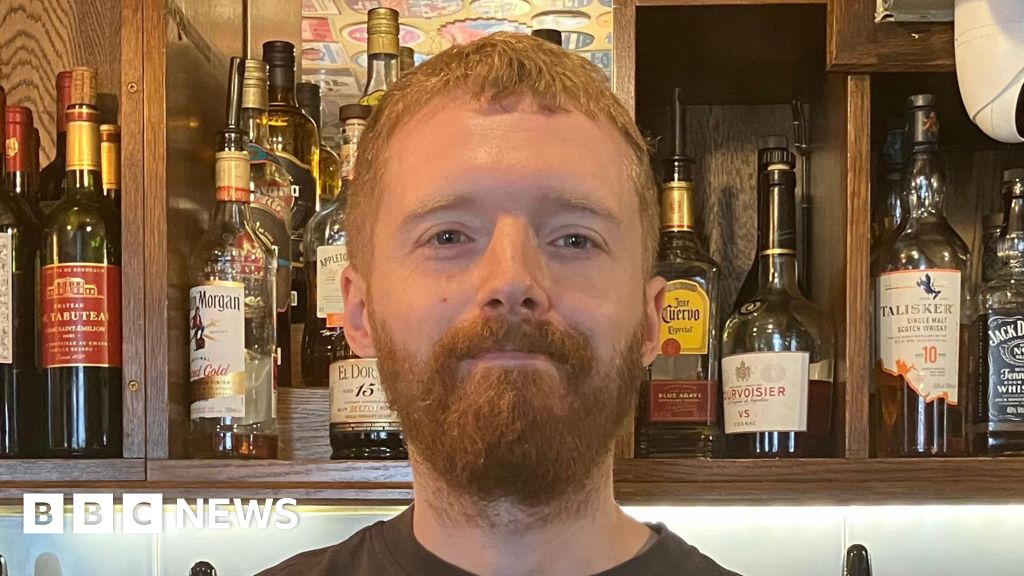
Berkshire pubs adjusting to post-Covid world, managers say
Neranjana ElapathaBBC Radio Berkshire
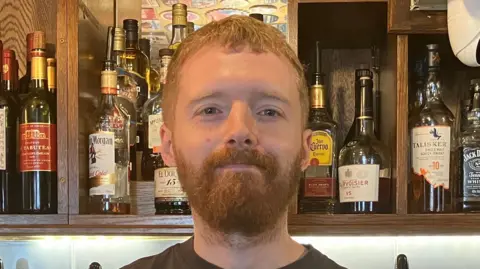 BBC
BBCRhys Vivian said some had recognised that putting on regular events was a good draw in pulling in punters Pubgoers’ habits have changed significantly since the Covid pandemic but they are still visiting their locals, a pub manager said.
Three pub managers in Wokingham, Berkshire, said trade at their venues remained healthy and they had all benefitted from the good weather over the summer.
Rhys Vivian, the manager of the Lord Raglan pub, said some had recognised that putting on regular events was a good draw to pull in punters.
“You can’t drag people from their back gardens and into the pub. It’s about giving them as many reasons to get them through the doors and think outside the box a bit more,” he said.
“Before [Covid] you may not have needed to put those [events] into place,” Mr Vivian, whose pub runs weekly steak nights, added.
“You would have enough people coming through the door but people now more than ever are looking to get value for money.
“There are plenty of places they could go over you but it’s about making sure that this is the particular place they would want to go to.”

Rachel Bell puts on regular charity events to support good causes Last month, UKHospitality said more than half of the UK’s job losses since the last budget came from its sector.
In analysis of Office for National Statistics data, it said job losses in restaurants, bars, pubs and hotels had totalled about 89,000 since October 2024.
Rachel Bell, the pub operator at the Roebuck, said it had benefitted from the recent good weather.
“The sunshine has helped us out with our garden,” she added.
Running a “community pub”, she tries to put on events that support local charities every month, supporting different good causes each time.
A recent event for the Firefighters Charity was held after a major fire in Bicester, Oxfordshire, which killed two firefighters and a member of the public in May.
William Upton, the general manager of The Rose Inn, said he had noticed people tended to now eat earlier in the evening.
Younger people often want to go out and do another activity at the same time and drinking tends not to be their “priority”, he said.
“With the cost of living, people only have so much money to spend and a lot of people now go out as a special occasion,” Mr Upton added.
Continue Reading
-
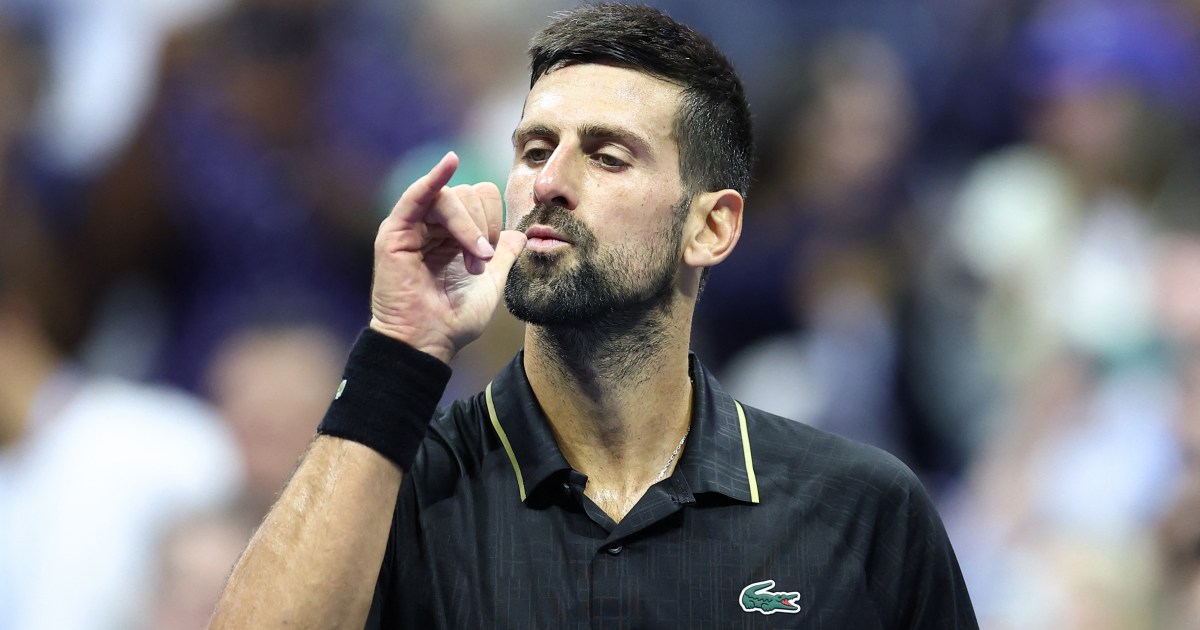
Djokovic to play Alcaraz in US Open semifinal after defeating Fritz | Tennis News
Published On 3 Sep 2025
Novak Djokovic set up a titanic US Open semifinal with Carlos Alcaraz as the Serbian star kept his bid for a record 25th Grand Slam firmly on track.
The 38-year-old Djokovic advanced to a record-equalling 14th US Open semifinal on Tuesday with a four-set win over fourth seed Taylor Fritz, eliminating the last American in the men’s draw.
Djokovic’s 6-3, 7-5, 3-6, 6-4 victory saw him improve to 16-0 against US opponents in New York, as he reached the last four of a major for the 53rd time.
“It was an incredibly close match. It was really anybody’s match,” said Djokovic, who also drew level with Jimmy Connors for the most US Open semifinal appearances.
“I thought I was really lucky to save some crucial break points in the second set. I think for most of the second and third sets, he was the better player.”
Fritz saved two match points in a tight fourth set, before sealing his own fate with a double fault.
“That last game was nerve-racking. A tough one for Taylor to finish with a double fault; he didn’t deserve that,” said Djokovic.
Djokovic and Alcaraz will square off for the first time since the Australian Open quarterfinals in January, when the Serbian won in four sets to take a 5-3 edge in their rivalry.
Friday’s encounter is their fifth at a Grand Slam, but first at Flushing Meadows. Djokovic has won all three past meetings on hard courts.
Djokovic will play in his 14th US Open semifinal – and 53rd major semifinal overall – when he takes on Carlos Alcaraz on Friday [Clive Brunskill/Getty Images via AFP] Djokovic spars with crowd, wears down Fritz
Djokovic broke Fritz straight away inside a raucous Arthur Ashe Stadium as he zipped into a 3-0 lead in the first set and brought up set point on his opponent’s serve in the eighth game.
Fritz resisted and piled on the pressure in the following game, earning five break points.
He could not convert, though, as Djokovic relied on his trademark grit to foil Fritz, including in an astonishing 25-stroke rally.
Djokovic eventually held to clinch the set, but Fritz carved out more chances in the fourth and sixth games of the second set.
His failure to capitalise allowed Djokovic to again seize the initiative by breaking for a 4-3 advantage. Fritz broke back with Djokovic serving for a two-set lead, only to tamely surrender his own serve with a double-fault in the ensuing game.
Djokovic made no mistake this time to pouch the set and mockingly blew kisses to the crowd as he walked to his chair.
But he began to get riled up with the pro-Fritz support willing their man back into the contest, prompting Djokovic to plead with the umpire to do more to quieten the crowd.
His focus dipped fleetingly, and Fritz broke to nudge 3-1 ahead and force a fourth set. It went on serve until Djokovic brought up two match points with Fritz trying to stay alive.
Fritz scrambled to save both, but Djokovic earned another shot and the American double-faulted to seal his rival’s passage to the last four.
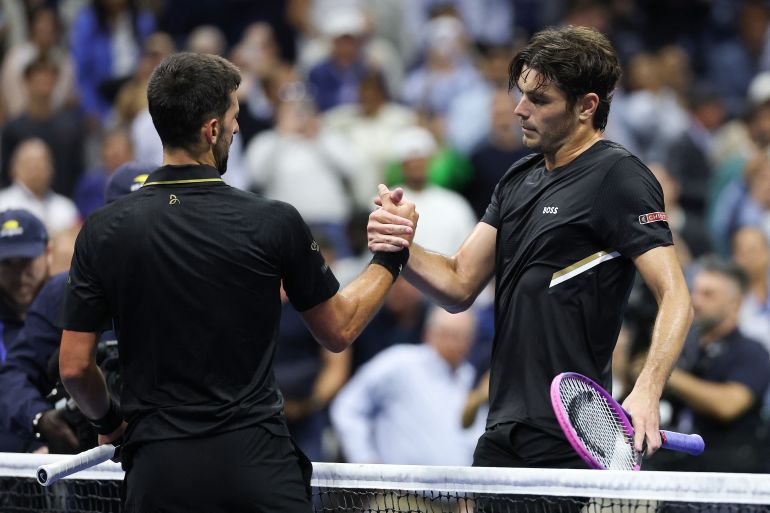
Djokovic, left, shakes hands after defeating Fritz in their quarterfinal match at the 2025 US Open [Clive Brunskill/Getty Images via AFP] Alcaraz demolishes Lehecka
Earlier on Tuesday, Alcaraz, who has yet to drop a set at Flushing Meadows in 2025, cruised into the semifinals, demolishing Czech Jiri Lehecka 6-4, 6-2, 6-4 on Arthur Ashe Stadium.
Alcaraz had the crowd in the palm of his hand as he fired off 28 winners and never faced a break point, putting on yet another almost pristine performance.
Alcaraz broke in the first game, helped on his way by a pair of Lehecka double faults, and the Spaniard got the crowd going as he triumphed in a thrilling, cat-and-mouse exchange at the net in the 10th game, sending a backhand winner streaking past the Czech.
The 2022 champion kept the momentum going in the second set, converting a break point at the net in the first game, and Lehecka became visibly agitated as he went down another break with a double fault in the seventh game.
Alcaraz smiled in disbelief as he nailed a series of precise shots to set up a break point in the seventh game of the final set, but Lehecka dug in to hold.
Alcaraz let out a triumphant cheer as he prevailed in a 12-shot rally on break point in the ninth game and deployed his golf swing celebration to the delight of fellow Spaniard and 2017 Masters champion Sergio Garcia, who was in attendance.
“I just played a really – or almost – perfect match,” he said. “I’m just feeling great and hungry to make it.”
The five-time major winner has only been broken once so far in the tournament and could retake the number one world ranking from Italy’s Jannik Sinner, although he is trying not to think about it.
“If I think about the number one spot too much, then I’m going to put pressure on myself, and I don’t want to do that,” he said.
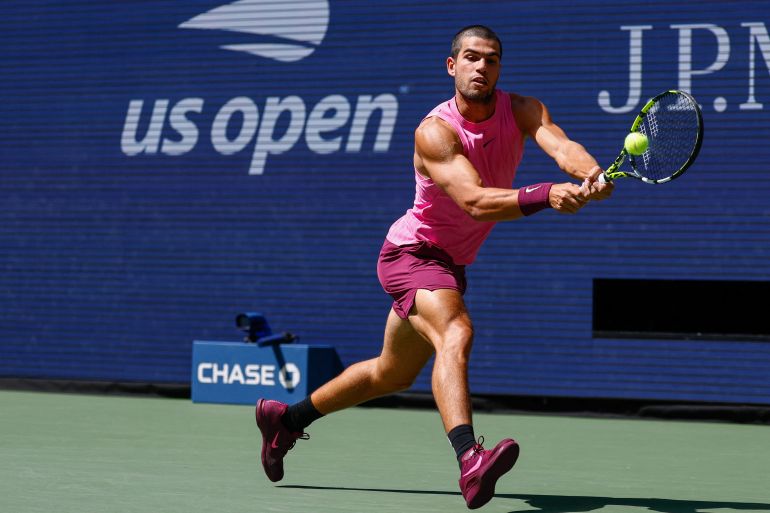
Alcaraz, at just 22, is in the semifinals at a grand slam for the ninth time. Only Rafael Nadal, with 10, had more before turning 23 [Kena Betancur/AFP] Continue Reading
-
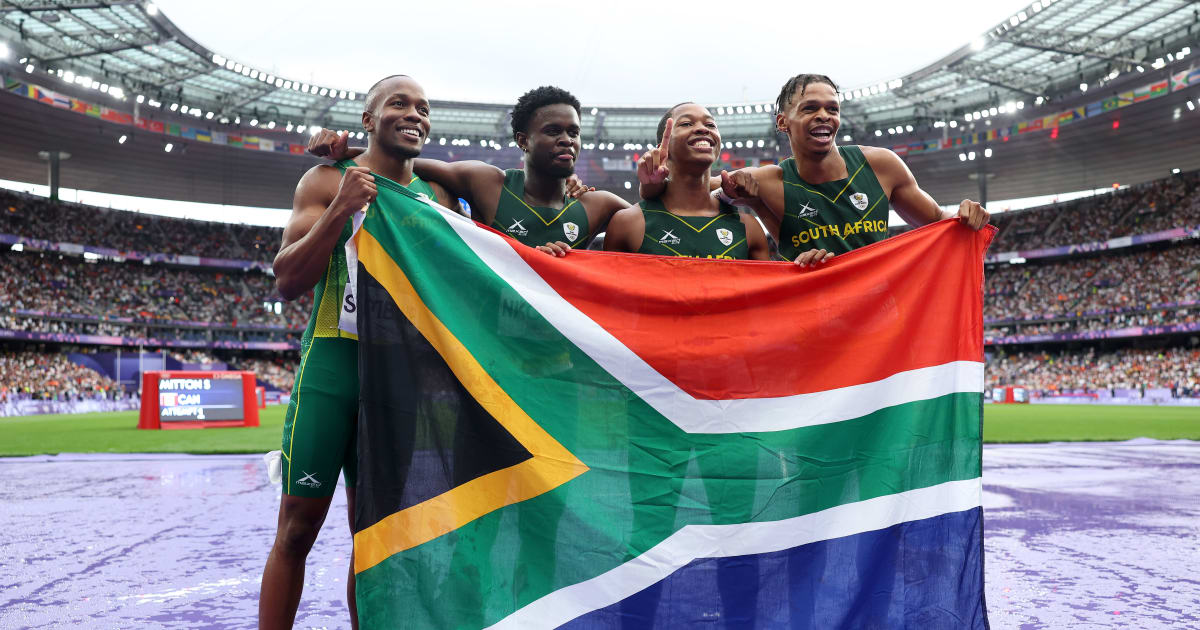
Wayde van Niekerk, Akani Simbine and Bayanda Walaza headline South African roster for the 2025 World Athletics Championships
There certainly won’t be a want for speed amongst Team SA at the 2025 World Athletics Championships, with the likes of 400m world record holder Wayde van Niekerk, three-time Olympic 100m finalist Akani Simbine and double World U20 champion Bayanda Walaza set to headline the African nation’s 49-strong squad at year’s most-anticipated athletics competition in Tokyo.
The speedy trio were amongst the 32 men and 17 women announced as entries by Athletics South Africa on Tuesday, 2 September, along with world indoor 800m champion Prudence Sekgodiso and javelin standout Jo-Ane du Plessis – a silver medallist at the Olympic Games Paris 2024.
While no specific medal target was set for the talented team featuring a mix of established stars and rising talents, hopes will be high for a strong showing in the Japanese capital.
Commenting on the announcement, Athletics South Africa President James Moloi stated, “This team reflects the dedication, resilience, and hard work of our athletes, coaches, and support staff, who have tirelessly prepared for this moment on both local and international stages.”
“Their selection is a recognition of excellence and a call to carry the South African flag with honour and pride.”
“We urge the athletes to remain focused, disciplined, and united as they take on the world’s best,” he continued, adding, “Championships of this calibre demand not only physical strength but also mental resilience, and we are confident that our team will rise to the occasion.”
Athletes from the Rainbow Nation will be especially eager to reverse their fate from the Olympic Games Tokyo 2020, which saw Team SA leave the historic city empty-handed and without much fanfare.
However, it’s unlikely that’ll be the case this time, with star-studded relay line-ups – boosting three medals (two gold and one bronze) from the 2025 World Athletics Relays – set to complement the African nation’s individual event entries.
There’s also the small matter of Bayanda Walaza’s return from apparent injury at the 2025 Diamond League Final, as the 19-year-old phenom attempts to prove he has what it takes to best the likes of Olympic champion Noah Lyles.
And don’t forget about Wayde van Niekerk – the fastest man in history over 400 metres.
He’ll look to prove himself against the world’s best as well, transitioning from a full lap sprint to a half lap sprint in an attempt to snag global headlines once more at the 2025 World Athletics Championships.
Continue Reading
